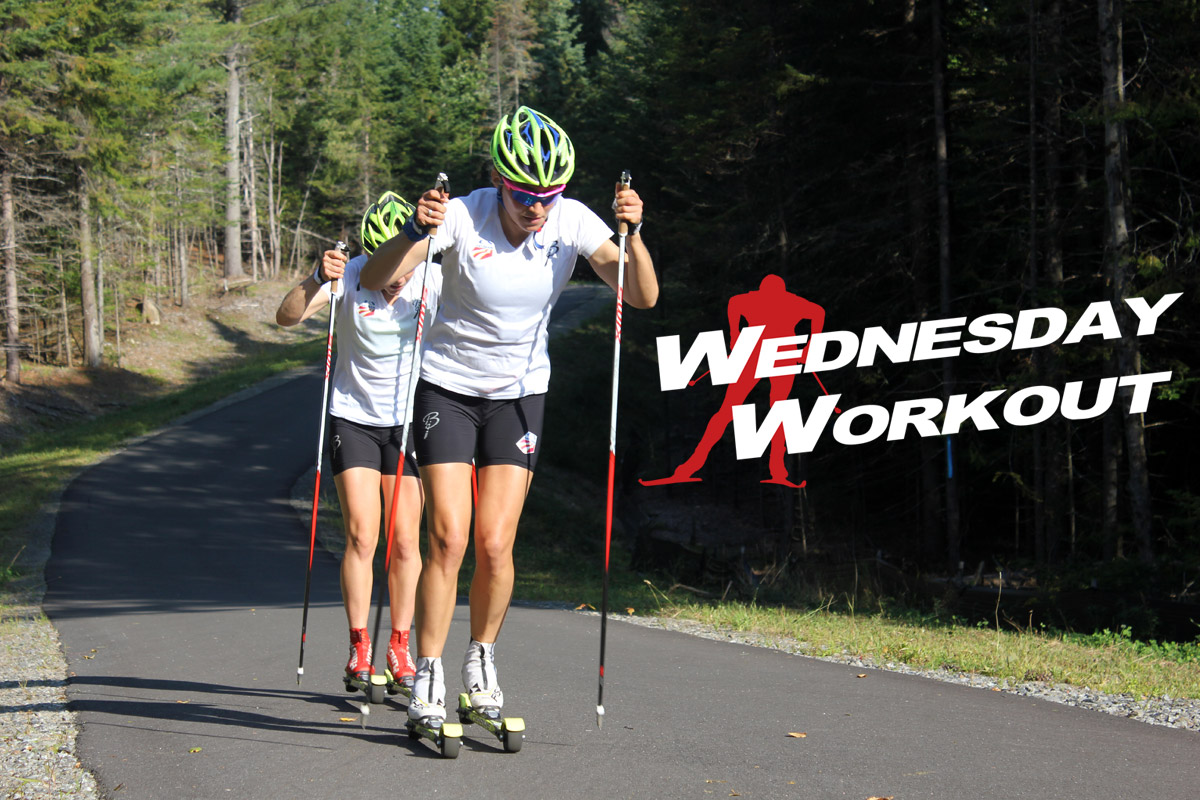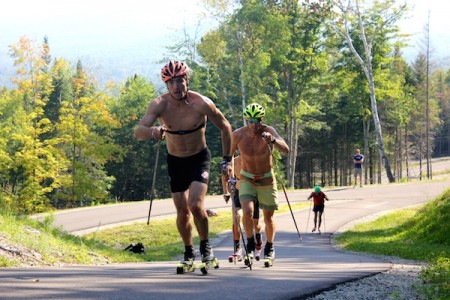
LAKE PLACID, N.Y. – Fall is just beginning which means leaf-peeping, cider donuts, and pumpkin spice lattes are likely on your radar. However, once you get your head out of the changing leaves it may be time to focus on some new training goals as winter approaches. If you’re looking to maintain a plan similar to the U.S. Ski Team, that means that you are focusing less on volume and more on intensity before you head into the depths of fall.

As part of their 2014 Lake Placid Fall Training Camp, the U.S. Ski Team took part in a classic speed workout aimed at activating quick twitch muscles and improving technical and tactical skills.
According to women’s coach Matt Whitcomb, the workout is part of a greater push by the U.S. Ski Team to include complex workouts that have various levels of development. The goal is to have sessions that not only increase fitness but also create an infrastructure for athletes to progress their skiing in a technical manner.
“At this time of the year we have tried to do is build an infrastructure for the athletes. The aim is create incredible workouts that have various levels of focus and various chapters,” Whitcomb said.
The Lake Placid workout does just that. Starting with an agility warmup, it progresses from eight rolling double pole speeds to eight striding speeds that are bound to make you analyze your technique and leave you out of breath.
The Workout: 1. Agility warmup 2.Two sets of four rolling double pole speeds on varying terrain 3. One set of eight striding speeds on an incline
Where: Olympic Jumping Complex, Lake Placid, N.Y.
What: Start your warmup as usual but after several minutes of easy classic skiing you should enter an agility course. This will not only help you warmup, but it will also help you engrain basic yet effective agility into your workout. The entire warmup should last roughly 20 minutes.
In Lake Placid the USST used the following exercises that were placed in a loop. Athletes then completed the loop as many times as they felt necessary.
– Right foot slalom (Enter a short slalom course with your left foot elevated and hop through the short course while keeping the left foot in the air)
– Left foot slalom (Opposite of the right foot slalom)
– Regular slalom
– Skip striding (Stride across a 50 m section while skipping during each stride. It creates an awkward feeling but after several attempts you should be able to get the hang of it.)
After completing the warmup pick two sections of a 500 to 1000 meter loop to do your rolling speeds. Each section should have varying terrain including corners and rolling hills that are suitable for double poling. The distance should be no more than 100 meters and should last roughly 15 to 20 seconds. Complete the loop once to get a feel for the terrain then ski the loop four times, each time rolling into an acceleration in the same speed zone. If you need to take another loop for more rest, do so. Once you’ve completed four speeds in one zone, repeat the process in the second zone. While you are competing these speeds make sure that you are conscious of the path you choose around corners. Many skiers often begin to turn into the corner too late. Draw a chalk arrow where you or your coach think it is best for you begin your turn as a friendly reminder.
When you’re done with the rolling speeds, find a short hill that requires striding. You will repeat a similar process as before, skiing in between each of your eight speeds. Before you begin each speed bring yourself to a complete stop and begin with a double pole start. Then progress into striding until you reach the top of the hill. To gain the most from this speed make sure that you enact a slight running technique. This will feel slightly awkward. While you will be sprinting up a hill, remember to be as relaxed as possible.
Once done with the eight speeds, cooldown by skiing 20 to 30 minutes.
Length: The entire workout should take anywhere from two to two and-a-half hours including warmup and cooldown.

With such a complex workout, there may be times when you feel as if your technique is less than ideal. If that’s the case, get a coach or fellow skier skier to watch you and give you some technique advice.
A unique aspect of the U.S. Ski Team is that they readily ask each other for help when they need it. If you want to train like the team, ditch the ego and ask your teammates, competitors, or random skiers for their advice.
“An athlete can be the best teacher because we’re actually doing the motions” Liz Stephen explained. “A coach can see it and they can know exactly what to say but for some reason I sometimes can’t compute it. I went through trying to learn that run technique and it wasn’t until the speeds were done that Ida [Sargent] said to me ‘I think about keeping my hands in sight when we’re doing this.’ As soon as she said that it clicked for me.”
To see more pictures from the workout check out our photo gallery from the training.

Lander Karath
Lander Karath is FasterSkier's Associate Editor from Bozeman, Montana and a Bridger Ski Foundation alumnus. Between his studies at Middlebury College in Vermont, he is an outdoor enthusiast and a political junkie.



